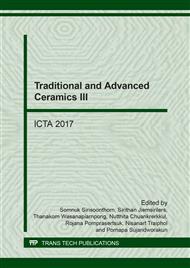p.246
p.252
p.258
p.264
p.270
p.276
p.282
p.288
p.294
Preparation of Porous Cylindrical Tubes Substrates from Zeolite and Clay for TiO2 Photocatalyst Coating
Abstract:
Titanium dioxide (TiO2) is the one of photocatalyst materials that widely used for decolorization of organic compounds in wastewater by photocatalytic mechanism which can be activated by UV light. Unfortunately, in the case of fine TiO2 power, filtration of the powder after water treatment process is difficult. In this research, coating or immobilizing the TiO2 powder on substrates using for removing the color of lignin concentration is interesting. The objectives of this research are to prepare the floating porous cylindrical tube substrates composed of zeolite NaA and ball clay, and then to determine the efficiency of lignin degradation. Zeolite NaA powder, Suratthani ball clay and organic binder solution were mixed before extruding and cutting to be 1.5 cm diameter cylindrical tube with 2.5 cm in length and 0.3 cm in thickness. After that, the dried tubes were fired at 650 - 800 °C for 2 hours and were then coated with TiO2-P25 suspension before re-firing at 600 °C for 1 hour in an electrical furnace. The fired uncoated tubes were characterized in terms of phase composition, porosity and radial crush strength. From the XRD pattern of the tubes fired at 800 °C showed that the zeolite NaA phase was disappeared. On the other hand, the zeolite NaA phase was found in the samples fired at another lower temperature. For the coated tubes, polyurethane foam was filled into the hole to make the tubes can be floated on the water surface. After that, the photocatalyst degradation property by determining the decreasing of concentration of lignin solution under tungsten lamp irradiation of the floated tubes were tested.
Info:
Periodical:
Pages:
270-275
Citation:
Online since:
April 2018
Keywords:
Price:
Сopyright:
© 2018 Trans Tech Publications Ltd. All Rights Reserved
Share:
Citation:


